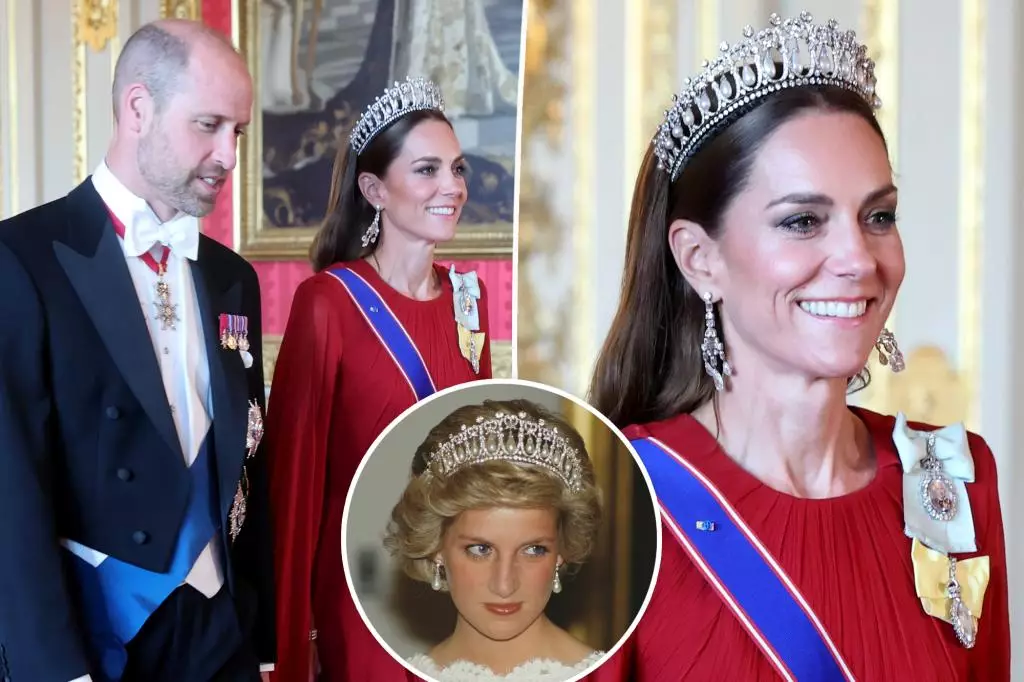Kate Middleton’s appearance at the state banquet exemplifies her mastery in blending tradition with contemporary elegance. Her choice to wear a striking red gown, designed by Sarah Burton for Givenchy, is more than just a fashion statement—it’s an embodiment of royal authority and confidence. Red has long been associated with power, passion, and leadership, and Middleton’s pick signals her intent to project a strong yet refined image on a diplomatic stage. The gown’s sweeping silhouette underscores her regal stature, yet the understated sophistication hints at her understanding of royal protocol and style. This calculated sartorial choice elevates her position, positioning her as a modern monarch-in-waiting who respects tradition while asserting her individual sense of style.
What truly distinguishes Middleton’s ensemble isn’t solely the dress but her deliberate nods to her royal heritage. Incorporating Princess Diana’s Lover’s Knot Tiara and pearl accessories from Queen Elizabeth II’s collection is an act of nuanced diplomacy. It signals respect for her predecessors while reinforcing her role as a custodial figure of royal legacy. By choosing to wear these iconic pieces publicly, Middleton transforms personal histories into shared national symbols, elevating her status within the royal family’s visual narrative. Her decision to combine modern design with meaningful relics isn’t merely aesthetic; it serves as a calculated power move—an assertion of continuity and tradition in an ever-evolving monarchy.
The Art of Nostalgia: Reframing Royal Identity via Jewelry and Attire
Royal jewelry has always carried emotional weight and historical significance, functioning as tangible links to eras gone by. Middleton’s strategic use of Diana’s Lover’s Knot Tiara, for instance, is a calculated display of affection and continuity. Officially returned to the Queen after Diana’s divorce, the tiara’s reappearance at major royal events signifies Middleton’s embracement of her role as Diana’s spiritual successor. The jewelry becomes a visual language that communicates her respect for the late princess—acknowledging her influence without overtly copying her style. This nuanced approach to inheritance and symbolism demonstrates Middleton’s awareness of her position within a complex web of royal narratives.
Furthermore, Middleton’s accessories—like the Nigel Milne pearl bracelet and the Greville Chandelier Earrings—are deliberate choices to evoke historical intimacy while maintaining a curated modern appeal. These pieces mirror her ability to navigate between generations and the expectations that come with them. Her styling choices, from her neutral makeup to her sleek hair, serve as a canvas that emphasizes the jewelry’s significance, ensuring that each element speaks to her diplomatic finesse and insistent presence as a future queen. Her fashion choices are less about vanity and more about meticulously crafting a royal persona rooted in legacy yet adaptable enough for contemporary relevance.
Crafting a Modern Monarch’s Persona amid Tradition
What makes Middleton’s approach to royal fashion remarkably insightful is her adeptness at balancing tradition with a fresh, accessible appeal. Unlike previous royal iterations that often adhered strictly to static notions of decorum and formality, Middleton introduces a nuanced modernization rooted in subtle symbolism. Her decision to rewear and reinterpret iconic elements—such as Diana’s tiara—positions her as a protector of royal heritage, yet with an innovative twist that resonates with younger generations.
This strategic presentation also reflects a keen understanding of the broader cultural landscape. In a time when monarchy faces scrutiny and demands for relatability, Middleton’s fashion choices serve as a bridge between reverence and approachability. Her ability to seamlessly blend historical relics with contemporary couture establishes her as a figure capable of evolving the royal image without losing sight of its foundational gravitas. Middleton’s sartorial diplomacy is a carefully calibrated act—a means to project strength, continuity, and relevance in an increasingly scrutinized institution.
Final Reflections: The Future of Royal Style Strategy
As Middleton continues to redefine royal elegance, her fashion sensibilities reveal a strategic mind that recognizes clothing as a potent tool for communication. Her sartorial selections are not accidental but are imbued with purpose—whether paying homage to Princess Diana or signaling her readiness to assume royal leadership. She understands that every gown, every tiara, and every accessory is an opportunity to reinforce her role as a custodian of tradition and a symbol of renewed monarchy.
In the grand tapestry of royal history, Middleton’s fashion narrative emerges as a masterclass in subtlety and intent. Each appearance is a carefully curated statement—an act of quiet power cloaked in timeless elegance. Her ability to balance reverence with modernity not only secures her position as a style icon but also as a future queen who navigates her responsibilities with grace, strategic foresight, and an acute awareness of her influence. The royal world watches as she crafts her legacy—one breathtaking look at a time.

